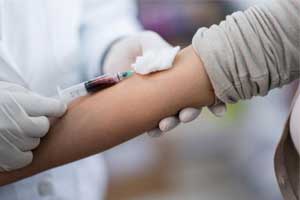- Home
- Editorial
- News
- Practice Guidelines
- Anesthesiology Guidelines
- Cancer Guidelines
- Cardiac Sciences Guidelines
- Critical Care Guidelines
- Dentistry Guidelines
- Dermatology Guidelines
- Diabetes and Endo Guidelines
- Diagnostics Guidelines
- ENT Guidelines
- Featured Practice Guidelines
- Gastroenterology Guidelines
- Geriatrics Guidelines
- Medicine Guidelines
- Nephrology Guidelines
- Neurosciences Guidelines
- Obs and Gynae Guidelines
- Ophthalmology Guidelines
- Orthopaedics Guidelines
- Paediatrics Guidelines
- Psychiatry Guidelines
- Pulmonology Guidelines
- Radiology Guidelines
- Surgery Guidelines
- Urology Guidelines
Scientists develop new blood test to predict spontaneous preterm birth

Boston, MA -- New blood test may predict spontaneous preterm birth and alleviate anxious pregnant ladies. Investigators from Brigham and Women's Hospital have developed a blood test to help predict who may be at increased risk and who may be at lower-than-average risk for spontaneous preterm delivery. The team presented the results from a multicenter study showing that five circulating microparticle proteins found in first-trimester blood samples may provide important clues about the risk of spontaneous preterm birth. Their findings have appeared in a paper published in the American Journal of Obstetrics & Gynecology.
Pregnancy can be a time of uncertainty for expecting mothers and their clinical care teams. Nearly 10 per cent of births are preterm, taking place before 37 weeks gestation. Preterm birth can result from several conditions, including preterm labour, preterm rupture of the placental membrane, or preeclampsia. Mothers who have previously had preterm deliveries are considered at increased risk, but predicting spontaneous preterm birth is challenging, particularly in the cases of first-time mothers, which account for about one-third of the nearly 4 million births nationally each year.
"A lot of the issues in pregnancy that result in spontaneous preterm birth begin at the end of the first trimester when the placenta becomes vascularized," said corresponding author Thomas McElrath, MD, PhD of the Division of Maternal-Fetal Medicine in the Department of Obstetrics and Gynecology at the Brigham. "Our goal is to develop prognostic markers for our patients to help make predictions and, ultimately, help us tailor treatment to the individual and offer highly personalized care to every woman from early on in her pregnancy."
McElrath and colleagues have found that proteins contained in circulating microparticles in the blood may hold important clues about spontaneous preterm birth. Circulating microparticles (CMPs) are tiny packages secreted by cells that can contain proteins, RNAs and other molecules that act as messages that can be transmitted from one cell to another. This form of cell-to-cell communication has largely been studied in cancer, but McElrath and others have wondered if CMPs have their evolutionary roots in the highly orchestrated but mysterious process of placental implantation. Proteins found in CMPs can be detected in blood samples from patients, making them a fairly straightforward readout--or biomarker--to study. In previous studies conducted by McElrath and colleagues, the team identified a group of five promising proteins that they hypothesized might predict preterm birth.
To validate this concept, the team leveraged blood samples collected toward the end of the first trimester of pregnancy from three established biobanks in Seattle, Boston, and Pittsburgh. The team compared samples from 87 women who delivered at or before 35 weeks to samples from 174 women who delivered at term and were the same age and at the same week of pregnancy at the time of the blood draw.
The team analyzed multiple CMP associated proteins but found that a subset of these proteins could help predict risk both for mothers who had previously given birth and for first-time mothers. For first-time mothers, if a woman's risk of spontaneous preterm delivery was 4.9 percent, a positive test result suggested a risk of 20 percent while a negative result reduced this to a 2 percent risk.
The team plans to validate its findings in a larger, national dataset, further refine the test, and include the addition of other risk factors such as maternal characteristics to further improve the test's accuracy. McElrath and colleagues also hope to use the same testing method to look for prognostic markers of other pregnancy-related conditions, such as gestational diabetes, so that with one test a detailed fingerprint of risk during pregnancy can emerge for each patient.
Currently, there is no treatment or prevention for spontaneous preterm birth, but McElrath hopes that prognosis will serve as an important first step toward therapy, particularly as investigators gain insights into its biological causes.
"What's most impressive to me is that this test suggests a way of identifying women who may be at risk who are having their first pregnancy. This group has always been a mystery. For the majority, we've simply Visit Sitehad to wait to see what happens. Now we are on our way to being able to predict what will happen and, in the future, build on this toward treatment," said McElrath.
For more details click on the link: http://dx.

Disclaimer: This site is primarily intended for healthcare professionals. Any content/information on this website does not replace the advice of medical and/or health professionals and should not be construed as medical/diagnostic advice/endorsement or prescription. Use of this site is subject to our terms of use, privacy policy, advertisement policy. © 2020 Minerva Medical Treatment Pvt Ltd